Issues in Domestic and International Healthcare
CUC’s Views on Healthcare and Social Issues
Rapidly declining birth rate, aging population, and shortage of medical professionals
In Japan, where the birth rate is declining and the population is aging rapidly, the demand for medical care is increasing, but there is a shortage of medical professionals.
It is predicted that by 2030 there will be a shortage of approximately 1.87 million* healthcare workers, making the sustainability of healthcare a critical issue. In the medical field, the normalization of overwork resulting in the increase of resignations is a serious social problem, and there is an urgent need to create an environment in which medical professionals can continue to work in a rewarding manner.
The CUC Group, which employs many healthcare workers, has established various systems to enable them to work with vitality and enthusiasm over the long term.
We believe that bringing smiles to the faces of healthcare workers will enable them to provide better quality medical services to patients as well.
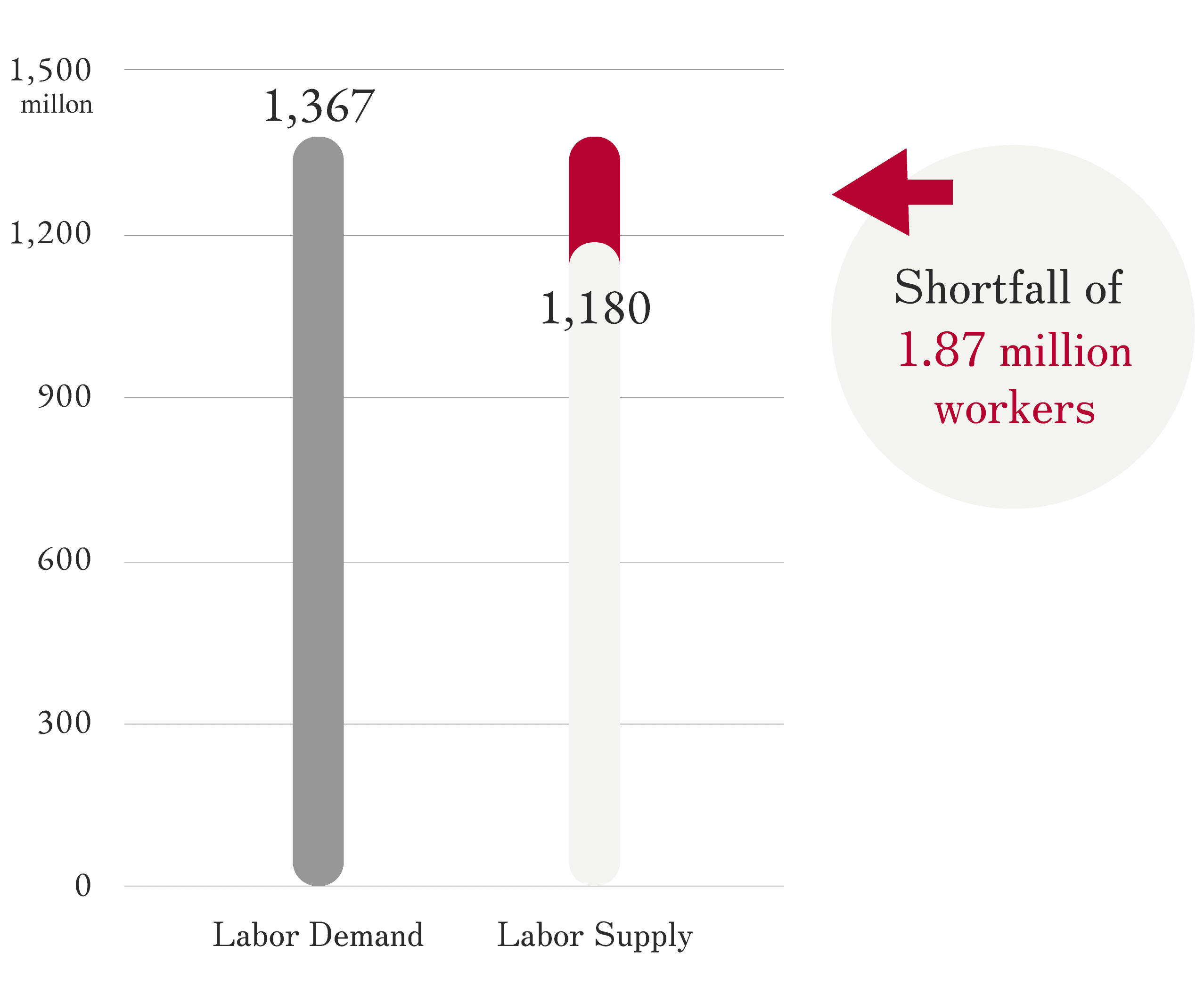
Labor demand: The GDP forecast by industry is calculated based on the forecast of real domestic production by industry for 2030 in the NIKKEI Center’s 44th Mid-term Economic Outlook. Labor demand by industry is calculated by dividing GDP by the productivity of each industry, assuming that the pace of productivity growth since 2010 will continue until 2030.
Labor supply: The relative share of the number of workers by industry (the share of each industry when the number of workers in all industries is set at 100%) is calculated based on the assumption that the pace of increase and decrease in the number of workers by industry since 2007 in the System of National Accounts(*) will continue until 2030. Labor supply by industry is calculated by multiplying the share (calculated using the aforementioned method) by the overall labor supply.
*The Japanese Cabinet office defines National Accounts, or SNA, is an international standard that aims to systematically record the flow aspects of a country’s economy, such as production, consumption, and investment, as well as the stock aspects, such as assets and debts.
CUC’s Approach
The CUC Group has many healthcare workers in the medical field, including nurses, therapists*, and caregivers. In order to provide high quality medical care to patients, it is essential to have a sustainable work environment where healthcare workers can continue to feel fulfilled in their work. For this reason, we have various systems in place that allow employees to work actively over the long term in accordance with their respective lifestyles. We deliver better medical care to patients by putting smiles on the faces of healthcare workers.
*Therapist is a collective term for physical therapists, occupational therapists, and speech therapists.
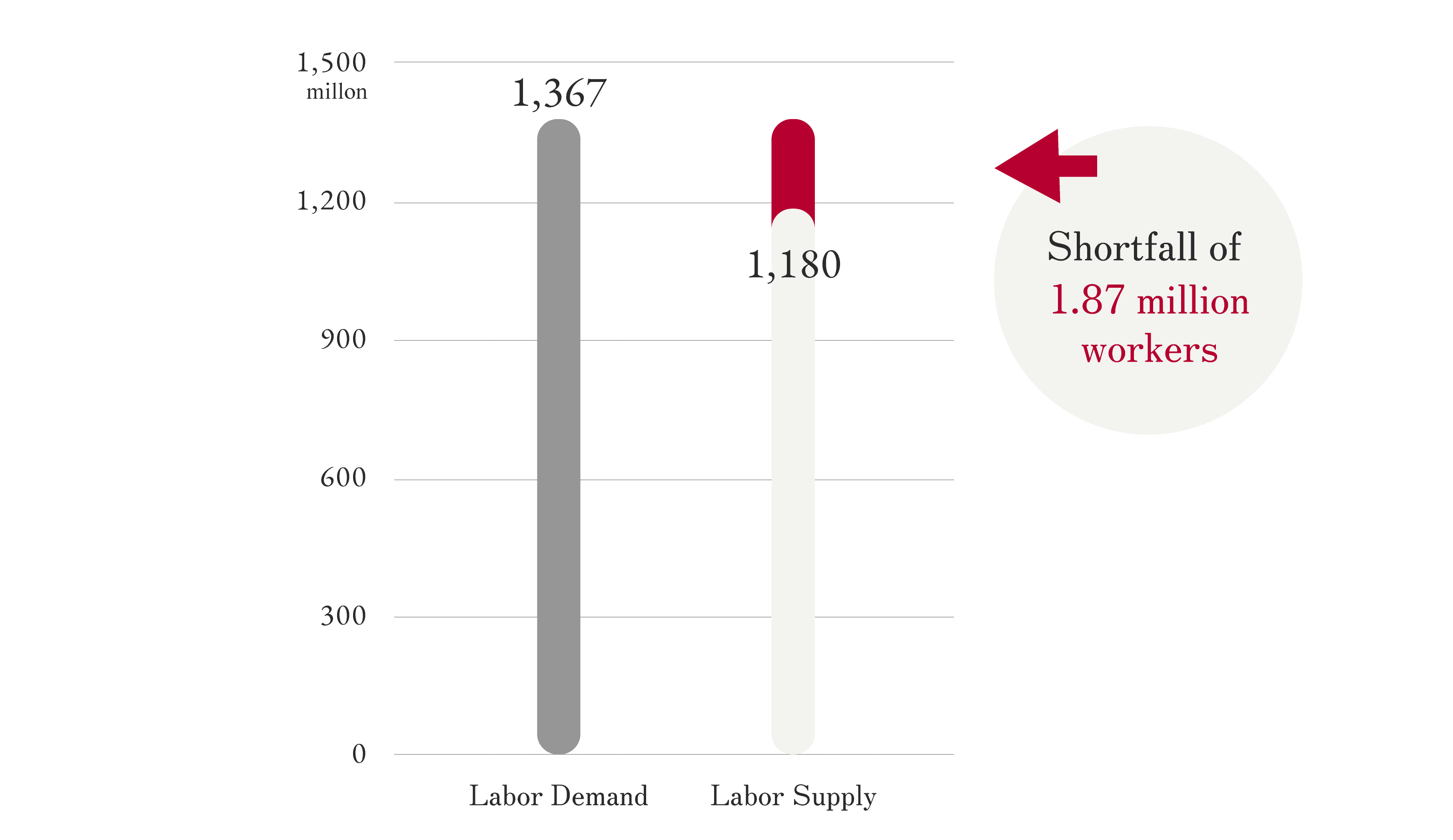
Labor demand: The GDP forecast by industry is calculated based on the forecast of real domestic production by industry for 2030 in the NIKKEI Center’s 44th Mid-term Economic Outlook. Labor demand by industry is calculated by dividing GDP by the productivity of each industry, assuming that the pace of productivity growth since 2010 will continue until 2030.
Labor supply: The relative share of the number of workers by industry (the share of each industry when the number of workers in all industries is set at 100%) is calculated based on the assumption that the pace of increase and decrease in the number of workers by industry since 2007 in the System of National Accounts(*) will continue until 2030. Labor supply by industry is calculated by multiplying the share (calculated using the aforementioned method) by the overall labor supply.
*The Japanese Cabinet office defines National Accounts, or SNA, is an international standard that aims to systematically record the flow aspects of a country’s economy, such as production, consumption, and investment, as well as the stock aspects, such as assets and debts.
It is forecast that almost half a million people may not have access to end-of-life care in 2040.
Japan is approaching an aging and multi-death society unlike any we have ever experienced. There is great concern that the number of people who die alone or without a specific place to spend their terminal days will increase.
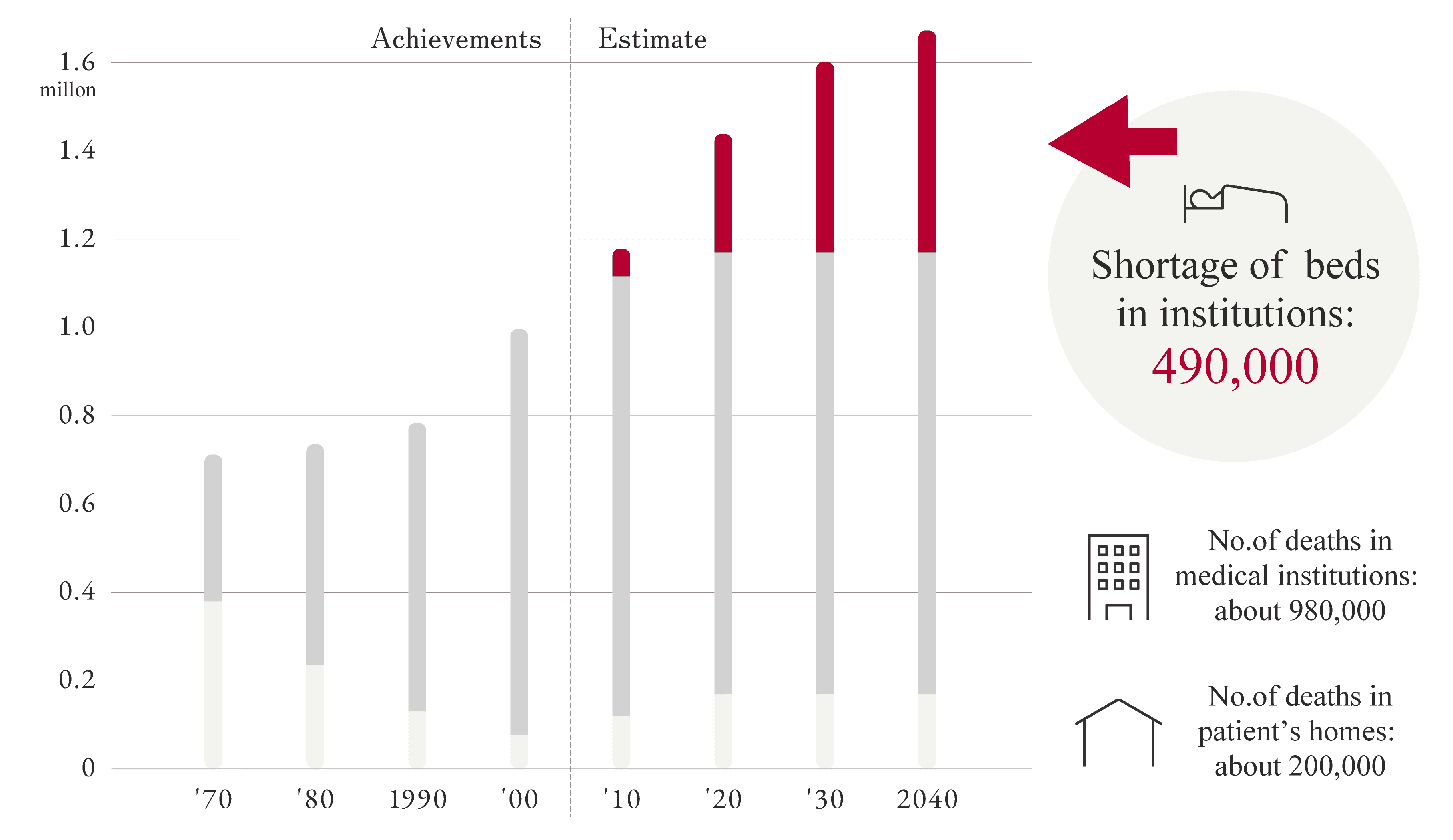
In 1976, the proportion of deaths at home and the proportion of deaths in medical institutions and other facilities reversed, and the proportion of people dying in medical institutions surpassed the proportion of those dying at home. If the relative numbers of deaths in medical institutions, and nursing homes, as well as the percentage of deaths at home, and the number of deaths in other locations as of 2007 remain the same, approximately half a million people are expected to be unable to access end-of-life care in 2040.
CUC’s Approach
We provide management support to other organizations and operate our own businesses with the aim of further expanding and enhancing home healthcare, a key service in a super-aged society. We aim to realize a society in which people can continue to live in their own homes by providing management and operational support for in-home care clinics, supporting the launch of in-home care businesses at core local hospitals, and operating nursing stations and hospices.

In 1976, the proportion of deaths at home and the proportion of deaths in medical institutions and other facilities reversed, and the proportion of people dying in medical institutions surpassed the proportion of those dying at home. If the relative numbers of deaths in medical institutions, and nursing homes, as well as the percentage of deaths at home, and the number of deaths in other locations as of 2007 remain the same, approximately half a million people are expected to be unable to access end-of-life care in 2040.
National healthcare costs are expected to continue to increase, reaching 78 trillion yen by 2040.
Japan’s healthcare expenditure has been increasing year after year. Although it temporarily fell by approximately 1.4 trillion yen year-on-year in 2020, partly due to the impact of the Covid-19 pandemic, it increased by approximately 2 trillion yen in the following year, 2021, reaching an all-time high. Due to the aging of society, medical expenses are estimated to grow to approximately 78 trillion yen by 2040(*). Medical expenses are covered mainly by public funds and insurance premiums, but the burden on the working-age population is becoming heavier each year due to population decline, making a review of the healthcare system an urgent issue.
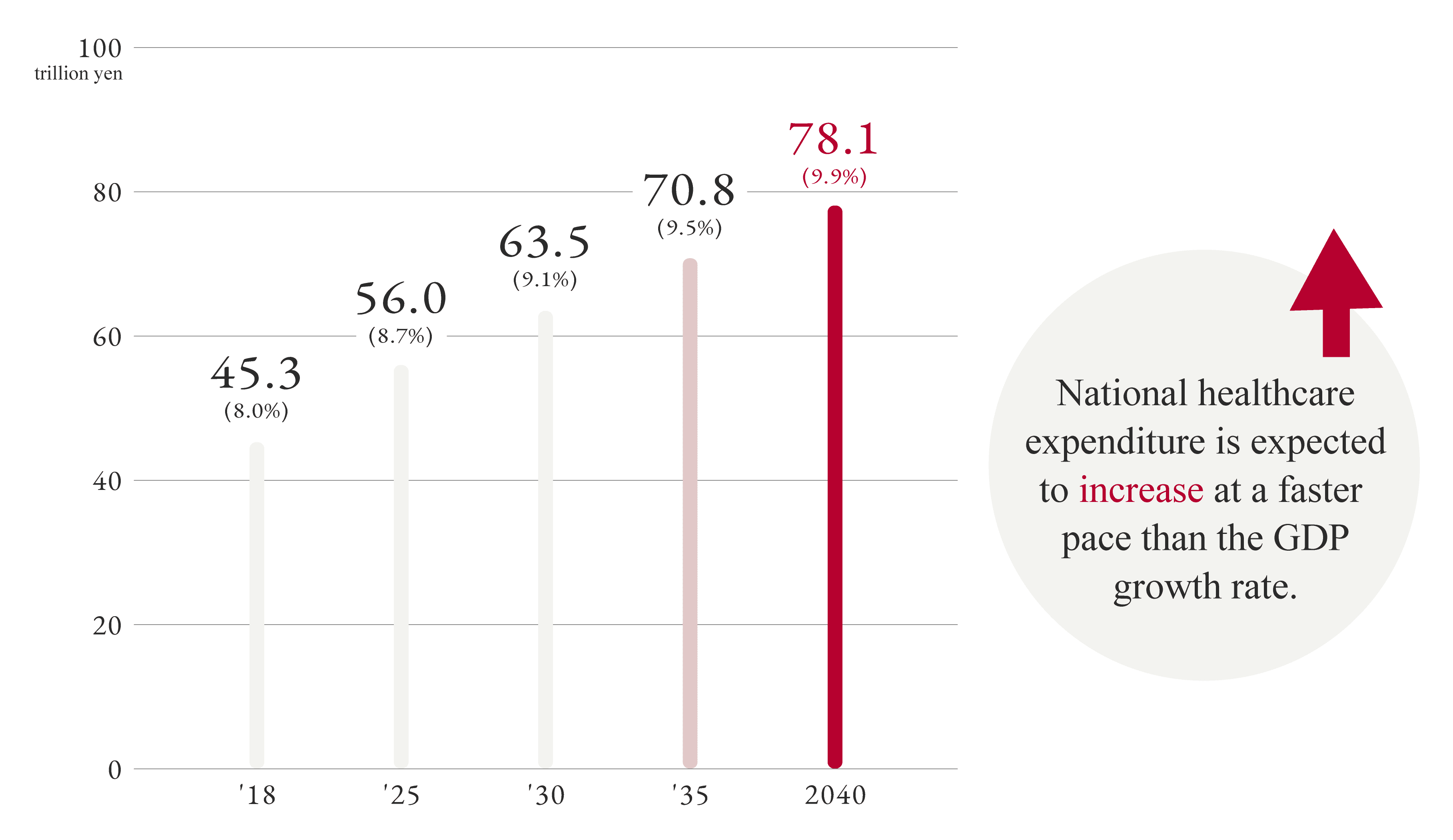
Figures based on future patient and user numbers calculated without excluding exceptions and based on current age group-specific receipt and utilization rates.
CUC’s Approach
Currently in Japan, reduction of hospital beds, reorganization of hospital functions, and promotion of home medical care are being promoted to curb the increase in medical costs. In addition, with the increase in the elderly population, there is a growing need to shift from acute care, such as surgery, to convalescent care, chronic care, and home healthcare, with the goal of returning patients to their homes. The medical industry is currently undergoing a major transformation to meet these social needs, and CUC aims to build a new healthcare system necessary for local communities by supporting the reorganization of hospital beds and the establishment of home healthcare support clinics, as well as by operating its own nursing stations and hospices.

Figures based on future patient and user numbers calculated without excluding exceptions and based on current age group-specific receipt and utilization rates.
Hospitals without suitable successors for aging high-level managers account for 68%.
As of 2020, 68.5% of Japanese hospitals were run by managers aged 60 or older (*1), and 68.4% of hospitals had no suitable successors as of 2017 (*2). If the aging of management continues without successors, business closures are inevitable, and it is expected that this will result in an inability to meet the future demand for healthcare in those regions.
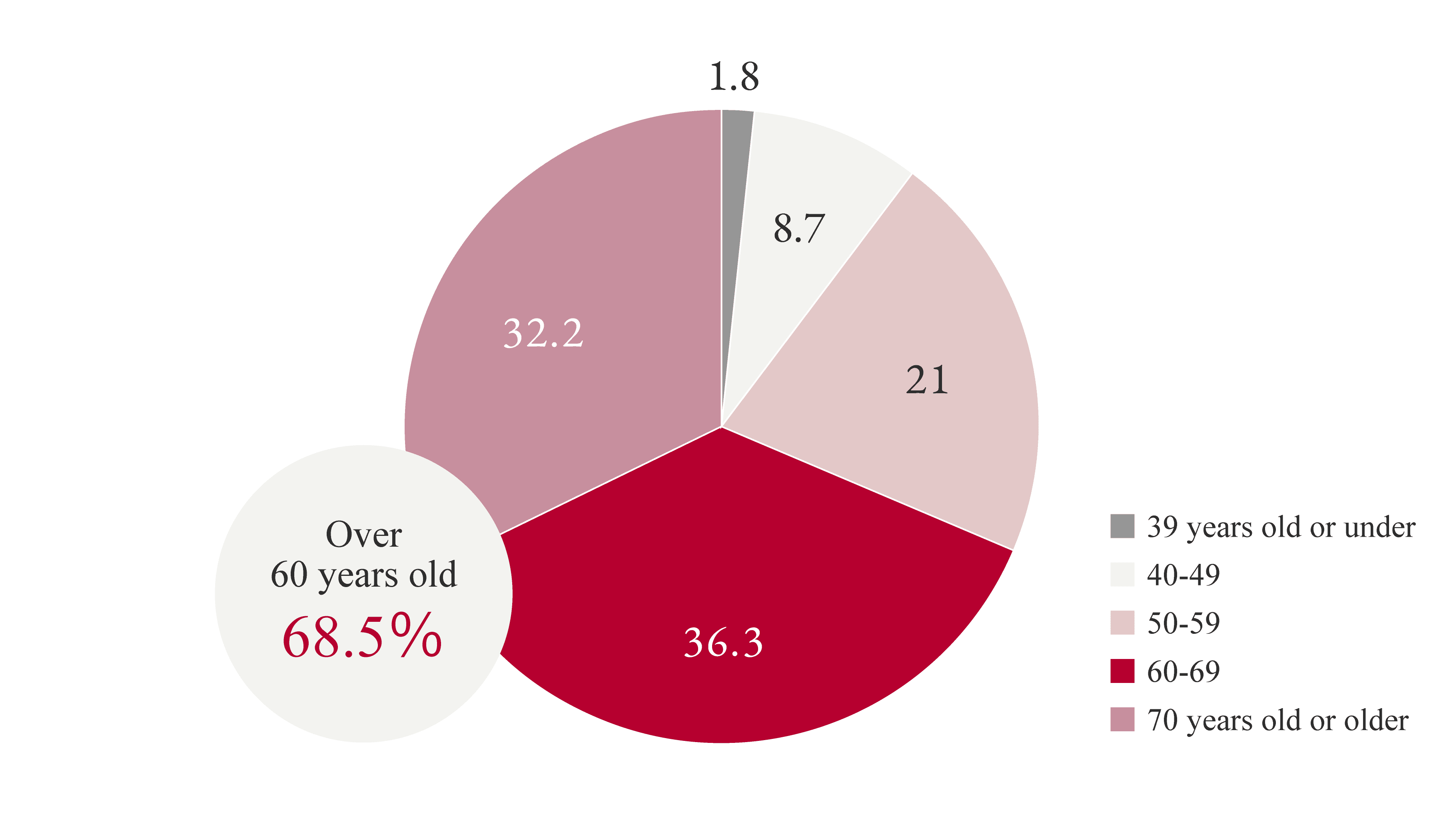
CUC’s Approach
CUC provides a wide range of management support services, including advisory services on business succession and post-merger integration, to medical institutions whose business continuity is in jeopardy, thereby ensuring successful business succession. Our management support is characterized by the fact that our support staff are stationed at the supported medical institutions and provide a wide range of services, from the formulation of management strategies and business management support to marketing support, staffing, IT, accounting, and other back-office operations. We strive to respond quickly and consistently to every situation to ensure successful business succession.

A majority of hospitals have financial difficulties.
In Japan, due to budget deficits, social compensation costs have been kept down by medical fee revisions and system changes, and the environment surrounding medical management has become increasingly challenging over the years. Recent data has shown that more than 70% of hospitals are in the red(*). If local medical institutions go bankrupt or are unable to provide adequate medical services, this will place a heavy burden on residents.
●Yearly change in the ratio (%) of the number of hospitals with a surplus/deficit based on the total profit/loss difference for one month.
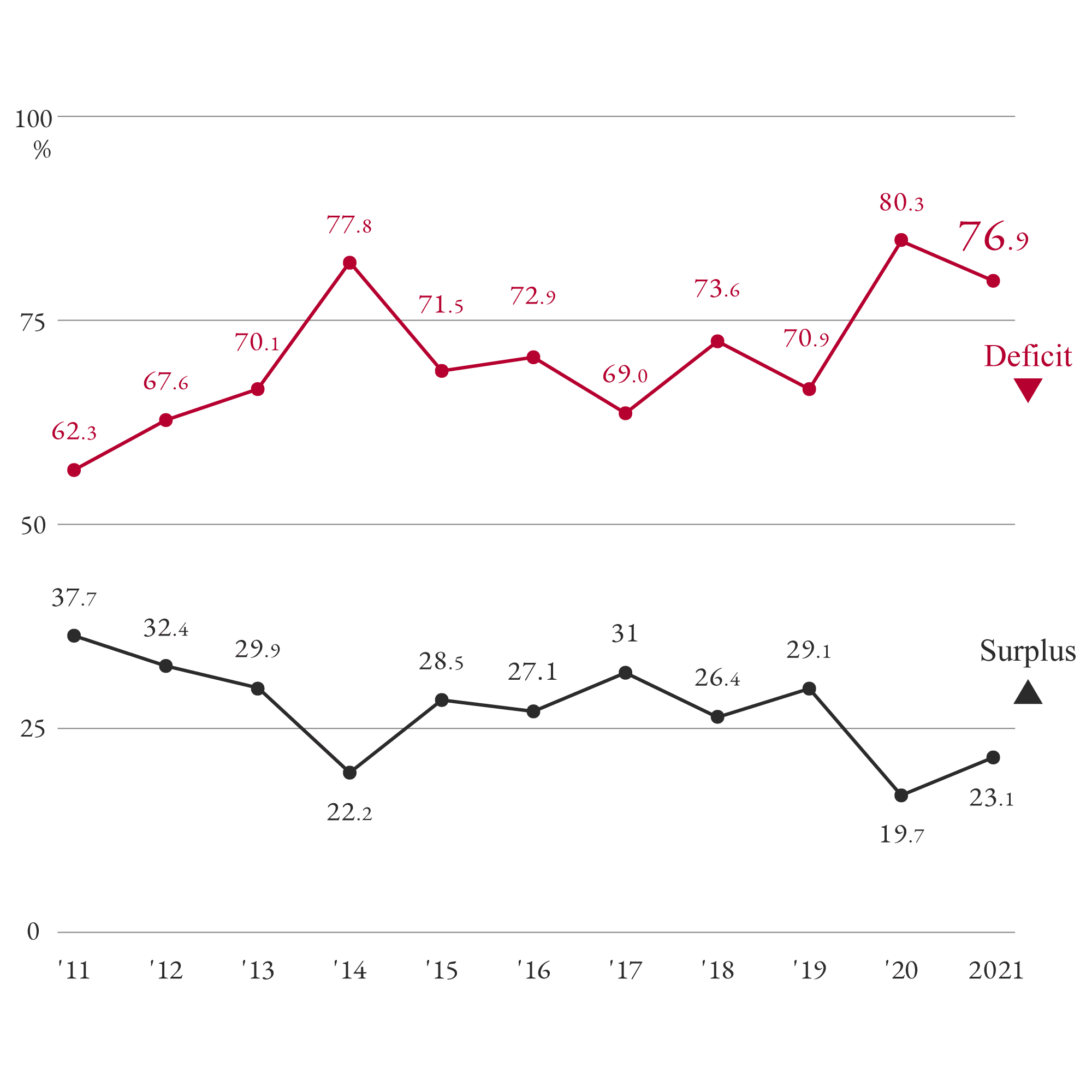
CUC’s Approach
CUC supports hospitals and clinics in a variety of ways, from management strategy to implementation. We also provide “hands-on” management support, in which CUC staff members are stationed at medical institutions nationwide to help create patient-oriented medical services tailored to regional characteristics. We support all functions related to the operation of medical institutions, including management strategy and administration, operational efficiency and cost optimization, recruitment, and organizational strengthening.
●Yearly change in the ratio (%) of the number of hospitals with a surplus/deficit based on the total profit/loss difference for one month.

One person dies from diabetes every six seconds worldwide.
The global diabetes population continues to explode and is projected to reach 700 million by 2045. The number of deaths from diabetes-related diseases will be 6.7 million, or one every six seconds. In developing countries, where medical resources are scarce and healthcare disparities are great, diabetes is often detected and treated late, leading to serious complications such as severe kidney disease requiring dialysis treatment, blindness, and amputation due to foot lesions. Diabetes is thus a major social problem.
●Estimates and trends of diabetes prevalence in the world (those aged 20-79years)
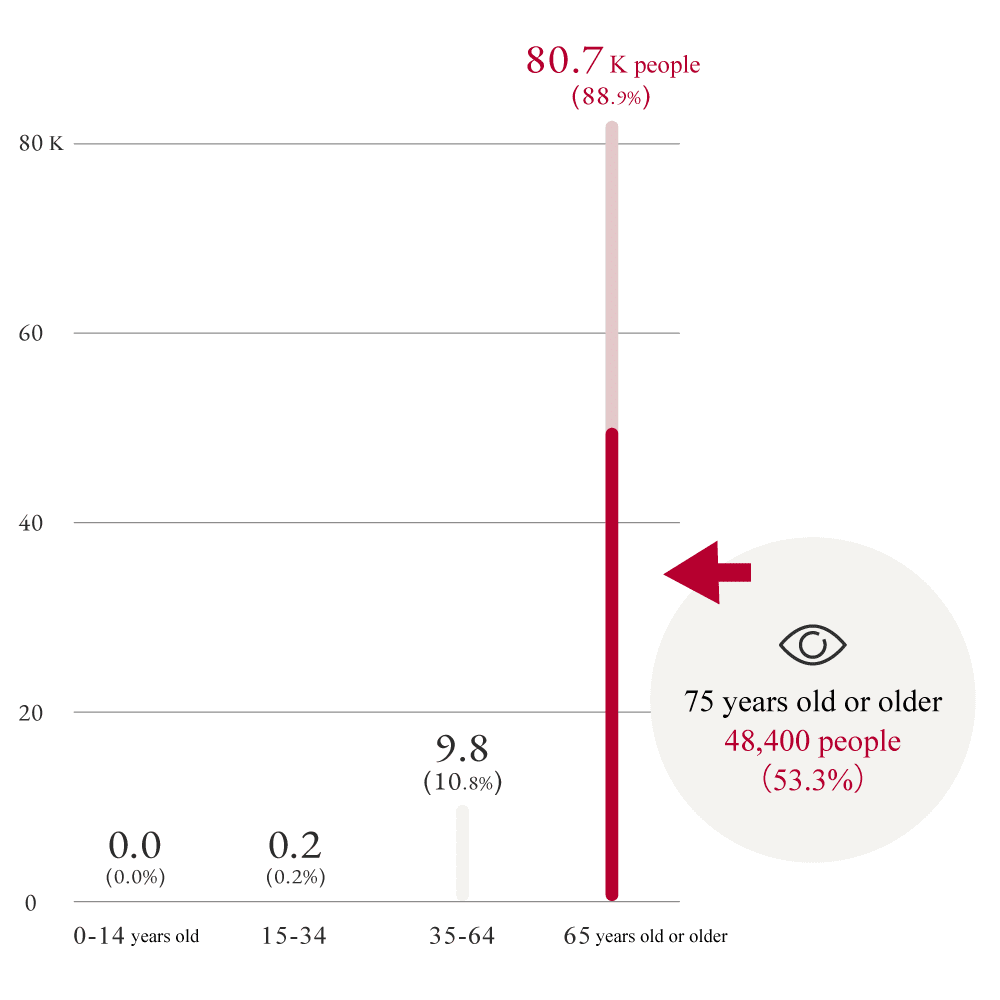
CUC’s Approach
Lifestyle-related diseases, such as diabetes, can be controlled if detected early and treated appropriately, and CUC has begun providing support to medical institutions in Vietnam and Indonesia by leveraging Japan’s advanced expertise in prevention, diagnosis, and treatment. CUC is working to improve the quality of medical care in developing countries so that there is no difference in the medical care available in different countries and regions, and is expanding its business around the world to fulfill its mission of Creating Hope through Healthcare.
●Estimates and trends of diabetes prevalence in the world (those aged 20-79years)

There are approximately 340,000 dialysis patients in Japan, and their medical expenses amount to 1.6 trillion yen.
Dialysis is a treatment that replaces kidneys that are no longer functioning properly and filters waste, toxins, and excess water from the body. The main role of the kidneys is to remove excess water, salt, and waste products from the body in the form of urine. However, when chronic kidney disease (CKD) progresses to chronic renal failure, the kidneys are not expected to regain function and alternative kidney treatments are needed. Dialysis requires treatment four hours a day, three times a week, and has a significant impact on a patient’s quality of life (QOL). Covid-19 is also of great concern to dialysis patients whose immunity is compromised due to renal failure. From another perspective, the scale of healthcare costs, which have ballooned to 1.6 trillion yen per year due to the increasing number of dialysis patients, should not be overlooked.
●Number of chronic dialysis patients(1968-2020) and prevalence rate (per million population, 1983-2020)
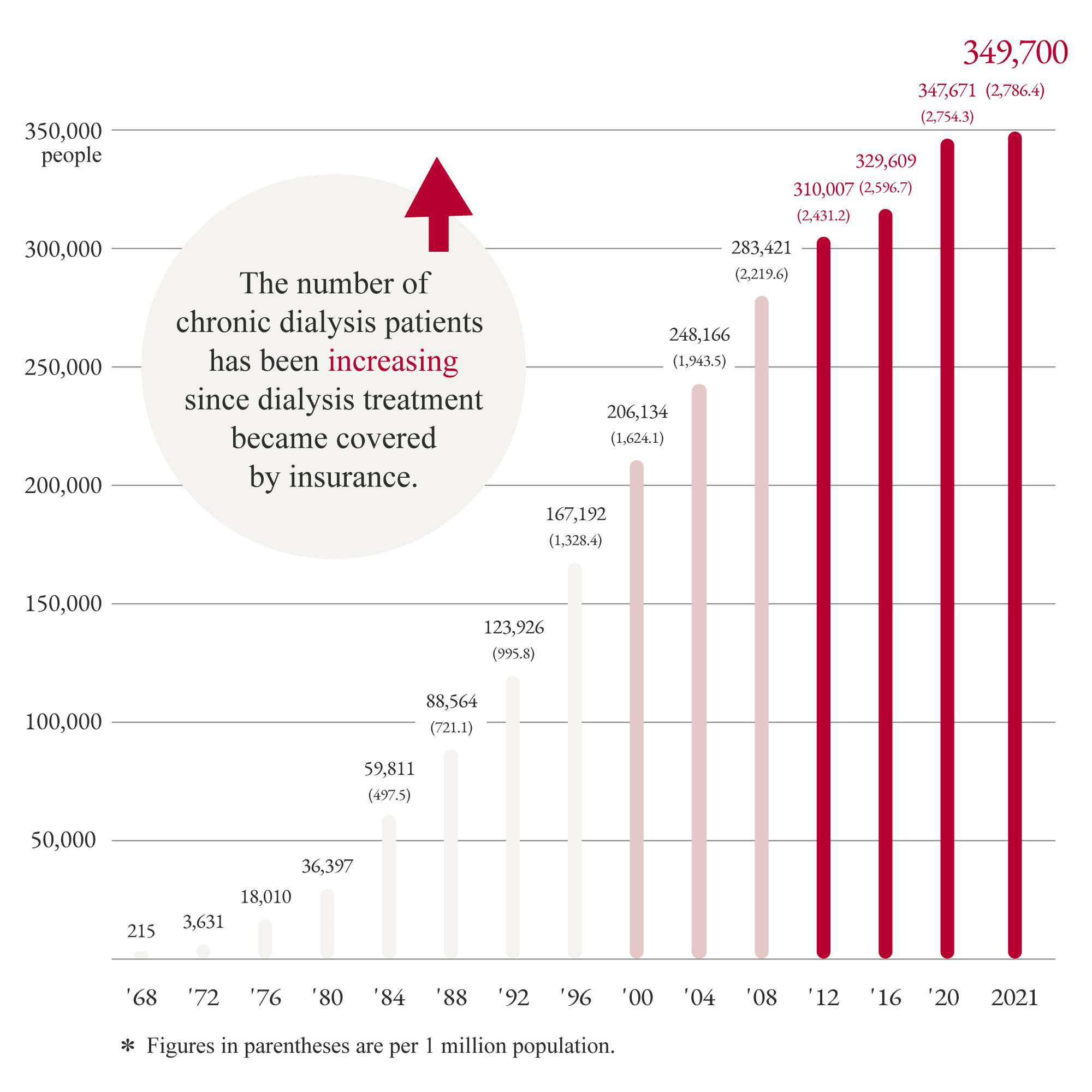
CUC’s Approach
We want everyone living with dialysis to lead a satisfying life. To this end, our priority is to help patients live longer and improve their quality of life while continuing dialysis treatment.
CUC will continue to provide management support for dialysis treatment facilities, train personnel involved in dialysis treatment, and conduct clinical, educational and research activities including preventive medicine.
●Number of chronic dialysis patients(1968-2020) and prevalence rate (per million population, 1983-2020)

About 90% of cataract patients are older than 65 years old.
Cataracts are a disease in which the lens of the eye becomes cloudy, making it difficult to see. It is closely related to aging, and according to a patient survey by the Ministry of Health, Labour and Welfare, the estimated number of hospitalized and outpatient patients in 2020 was 70,900, 88.8% of whom were over 65 years old. The mainstay of cataract treatment is surgery to replace the cloudy lens with an artificial intraocular lens. In the past, the main goal was to prevent blindness, but now that surgical methods have advanced dramatically, various types of intraocular lenses are available, and we are entering an era in which better vision can be pursued.
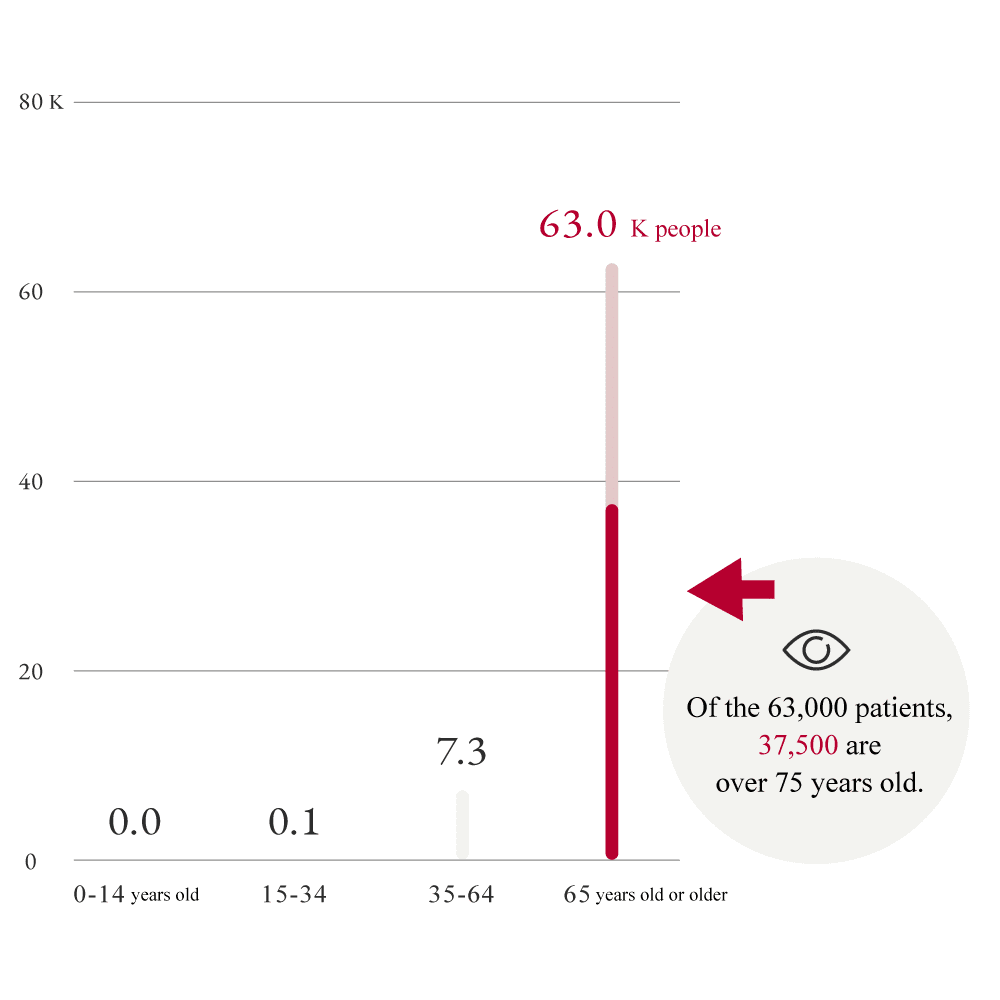
CUC’s Approach
Difficulty in seeing has a significant impact on the quality of life (QOL) of the elderly. In Japan’s super-aging society, a rapid increase in the number of cataract patients is inevitable in the future. CUC is helping to increase the number of clinics across the country that can provide high-quality surgery in the field of ophthalmology while being aware of patients’ concerns. We are also working with medical institutions in the field of medical care for the elderly, including in-home care, to build a system that enhances the QOL of the elderly in multiple ways.

The number of children requiring regular medical care has doubled in the past 15 years, reaching approximately 20,000 in Japan.
Due to advances in medical science, the number of children requiring daily medical care such as suctioning of sputum and tube feeding, using ventilators and gastric bandages even after admission to the NICU, has doubled over the past 15 years. On the other hand, the number of pediatricians supporting these children has been decreasing, and there is a need to create a social infrastructure to support children requiring medical care and their parents.
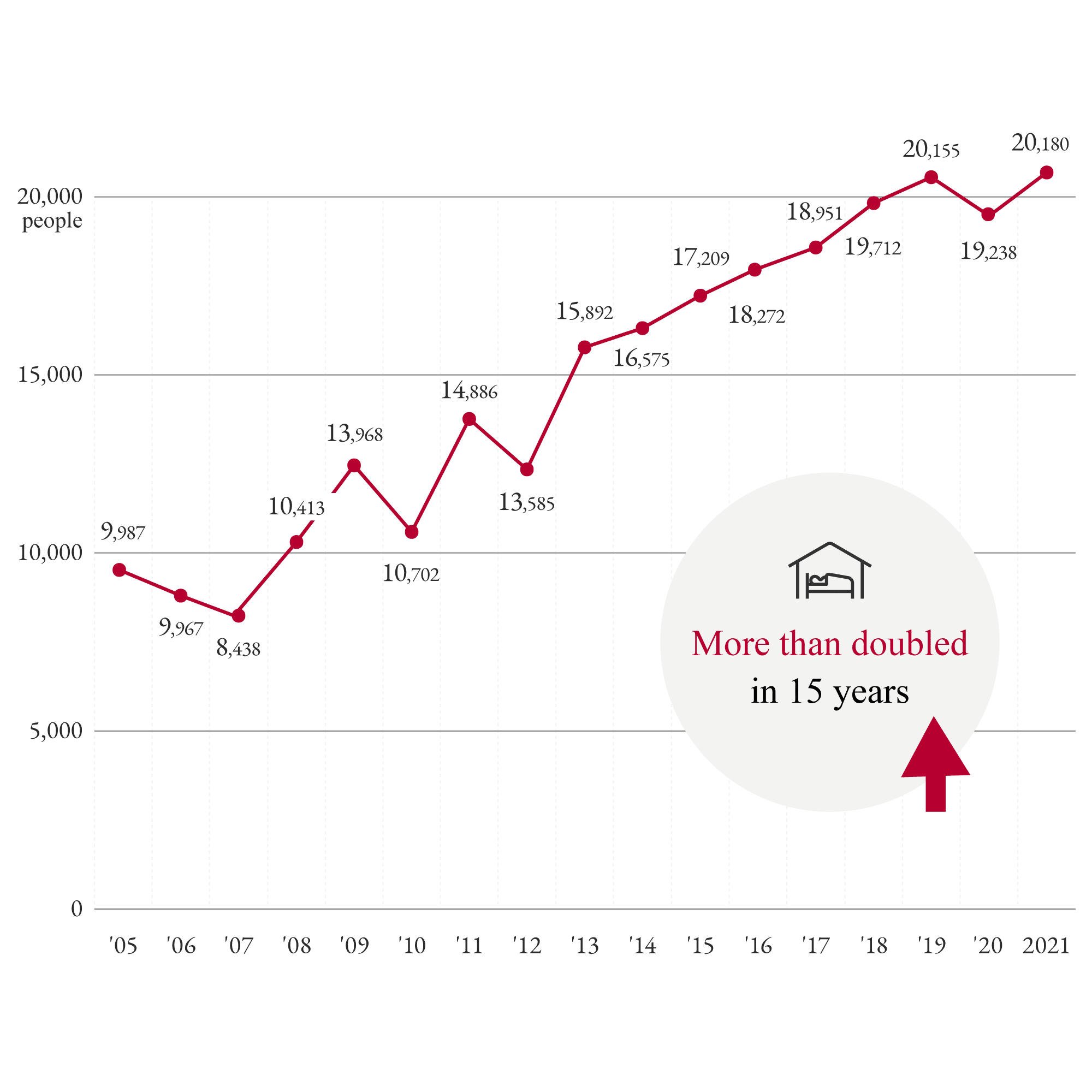
CUC’s Approach
In 2020, we began supporting the establishment of pediatric outpatient clinics that are available 365 days a year. We will support the creation of medical care that is needed by parents raising children. Through the establishment of a comprehensive pediatric medical platform that aims to resolve various medical issues related to children, we aim to create a system that supports the entire community in which children, their parents, and their families are supported.



